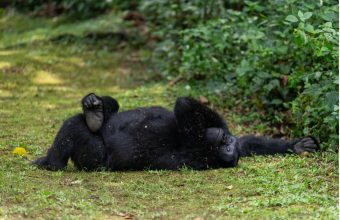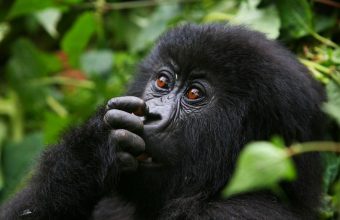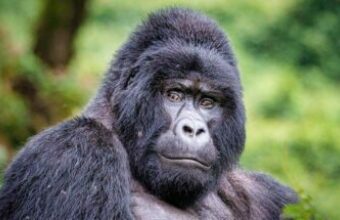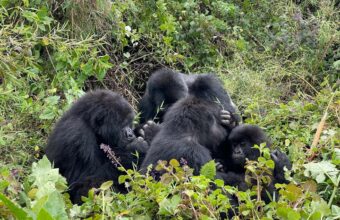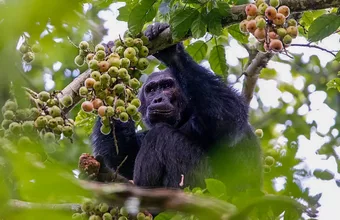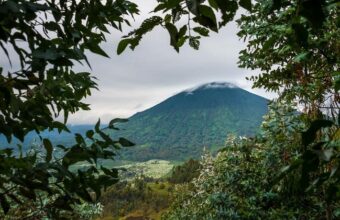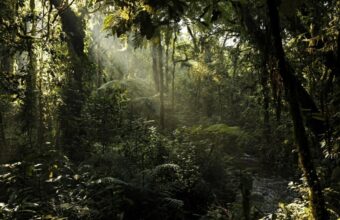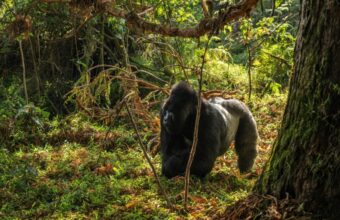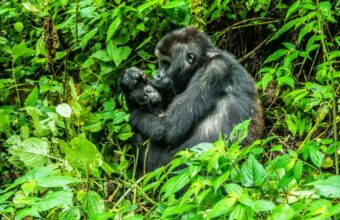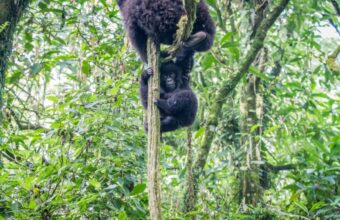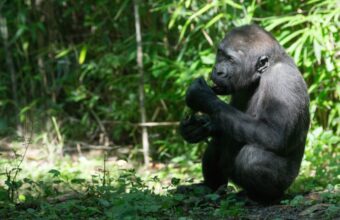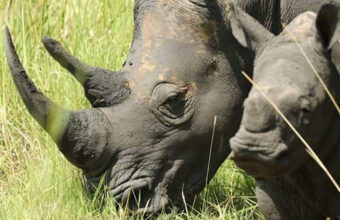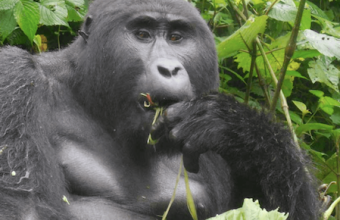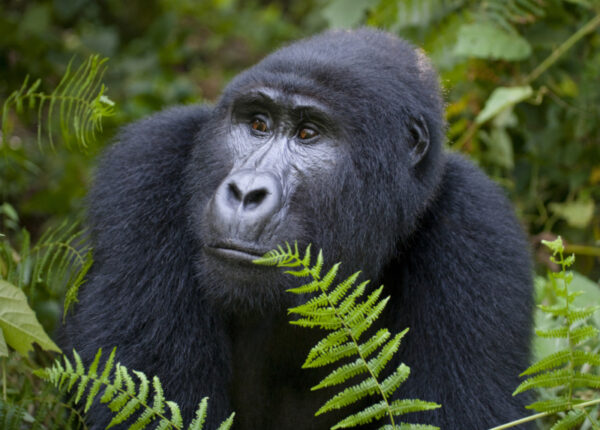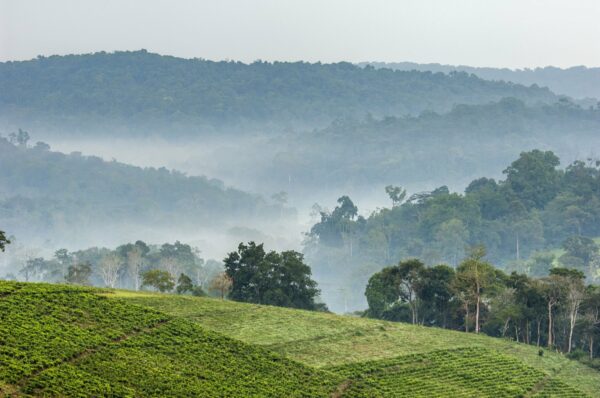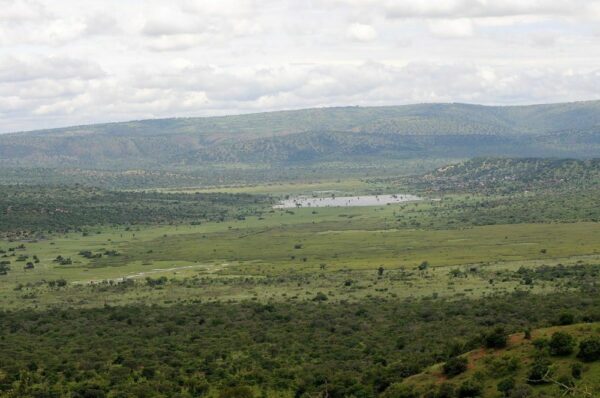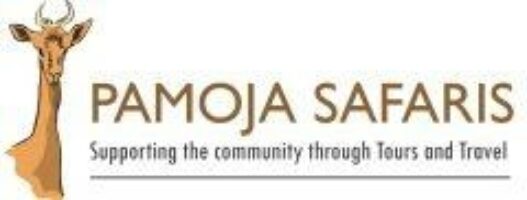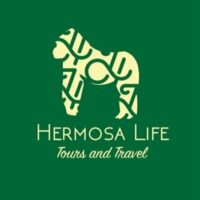Gorilla trekking
How and where to see gorillas in the wild
Before Sir David Attenborough’s landmark TV programme, Life On Earth, gorillas were seen largely in a negative light, based on King Kong and cheap B-movie monsters. At one point, a survey of the world’s most feared animals featured gorillas alongside sharks and spiders.
Seeing this popular TV personality interacting with friendly gorillas changed all that. The famous sequence of Sir David’s encounter and his awe for the gentle giants helped bring a new understanding of their true nature to TV screens around the world.
Today gorilla trekking in Rwanda and Uganda are both countries' biggest draw for international visitors. Perhaps there's something about these creatures' gentle vulnerability despite their colossal size that triggers a sense of empathy for our distant cousins. Do we see something in them that we wish we saw in ourselves? Whatever the appeal, visitors who come to spend a magical moment with the gorillas describe a life-changing experience.
Gorilla trekking: Overview
As a guidebook writer specialised in East Africa, I’ve been gorilla trekking at least a dozen times in three different countries. It’s an experience that never gets old. On the contrary, every gorilla encounter is different. You might find yourself sitting a few metres from a barrel-headed silverback as it delicately shreds a bamboo shoot, or exchanging a questioning glance with a curious middle-aged mama, or watching a young hooligan climbing ineptly up a liana and tumbling playfully back to the ground. However your encounter plays out, anybody who has looked into the soft brown eyes of a gorilla will confirm that it is an awesome experience.
On the following pages you'll find our expert guide to gorilla trekking in Uganda and Rwanda, but for quick reference here's what you need to know:
- Rwanda is significantly more expensive with accommodation and tours skewed to the luxury end of the market. The gorilla trekking experience in Rwanda is more accessible and convenient. If you have less time, or are a less confident hiker, I normally suggest Rwanda. See our country comparison here.
- Gorilla trekking in Uganda is cheaper and more diverse than in Rwanda, with accommodation for a wider range of budgets and a greater range of activities. If you’re on a tight budget, or you’re looking for a longer, more varied and more adventurous trip, I’d probably recommend Uganda.
- Wherever you go, gorilla tracking permits are required and can be scarce: book well ahead if you're travelling in peak months.
- It's a year-round activity, but the best conditions are during the dry seasons.
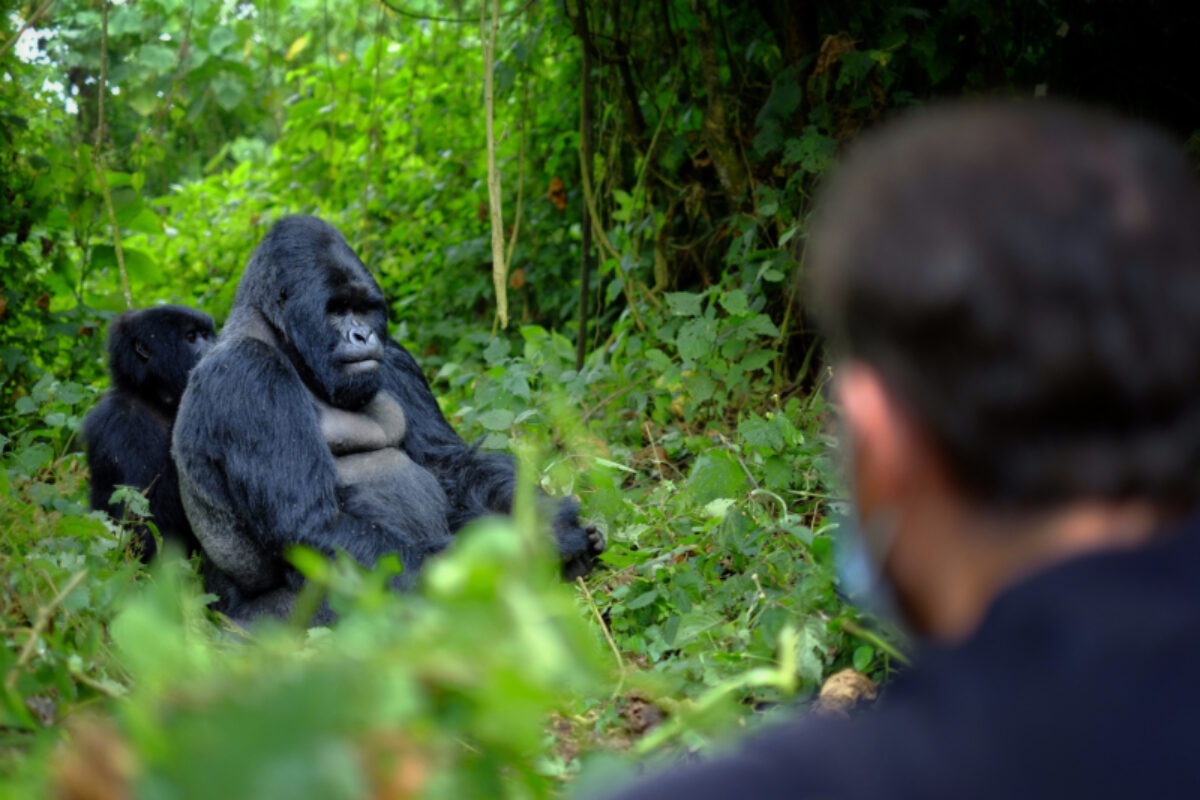
One magical moment: coming face to face with mountain gorillas in Uganda
Where to go gorilla trekking
The best places to see gorillas in the wild
In the wild, gorillas are found in 10 countries in the equatorial African rainforest, of which Rwanda and Uganda are by far the main locations for commercially-organised gorilla trekking.
-
Volcanoes National Park
-
Bwindi Impenetrable National Park
-
Mgahinga Gorilla National Park
-
Kahuzi-Biega National Park
-
Virunga National Park
-
East Africa
Gorilla trekking: Need to know
Everything you wish you'd known before you booked
Gorilla trekking in Rwanda and Uganda is a developed and well-organised industry with few pitfalls to be aware of. The following pointers will help you plan a seamless trip.
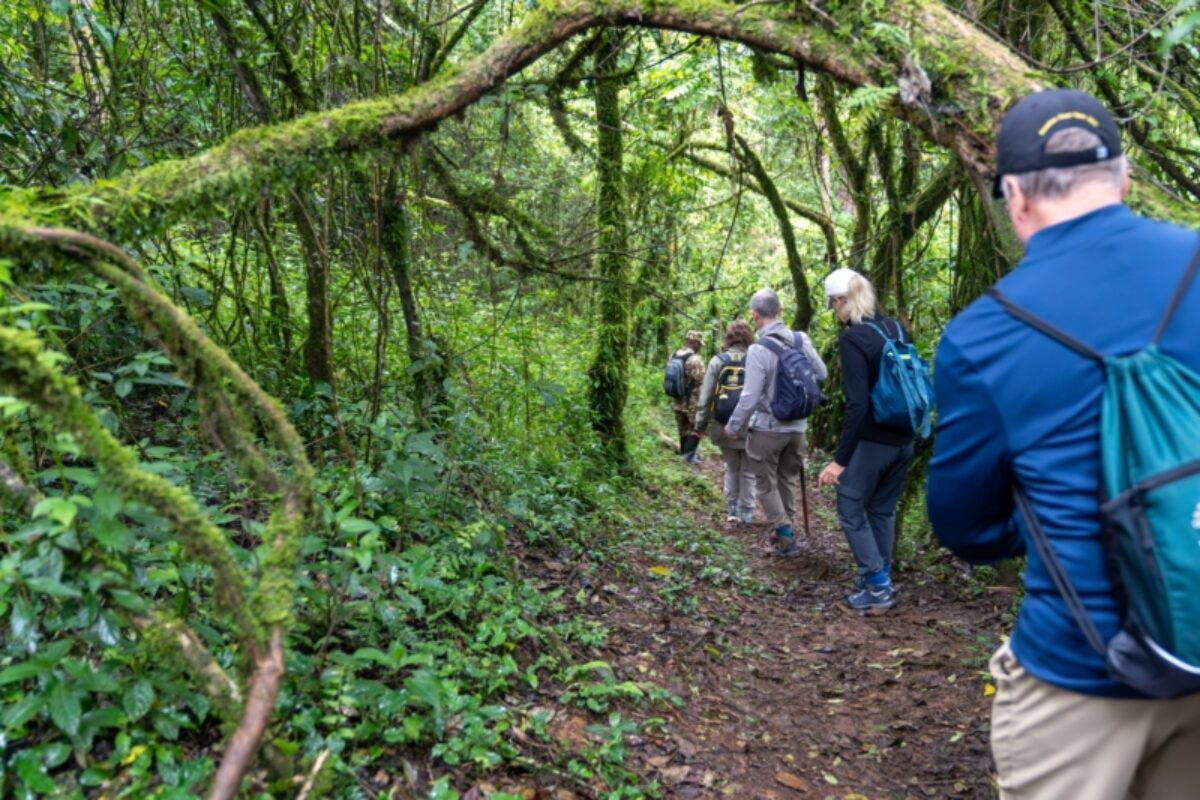
Trekking to meet the gorillas in Rushaga, Bwindi Impenetrable Forest
What’s gorilla trekking like?
It’s a big day with an early start and potentially hours of hiking, so make sure of an early night the day before. I was so excited on the eve of my first gorilla trek that I barely slept a wink.
Your lodge or tour operator will organise a transfer to the park headquarters for registration and a briefing around 7:00am. You’ll get an important reminder of the regulations and safety guidelines and your group will be assigned to visit a specific gorilla family.
You’ll usually trek for at least an hour before you reach your gorilla family. In some cases, it may take three or more hours before you find your group.
The scenery is stunningly beautiful, and the hike is all part of the experience.
As you come within range of your gorilla family, you’ll leave your bags so you can approach the group more closely. Once you make contact, you’ll spend an hour with the gorillas. They may be hanging from trees, grooming, suckling their babies, playing, sleeping, farting or mating. Your hour with the gorillas may be calm or it may be full of drama! One thing is for sure, the hour will fly by. My biggest tip is to just enjoy being in their presence: don’t spend the whole time watching them through your camera screen.
If the gorillas are on the move, you’ll be able to move with them, keeping the required minimum distance of ten metres at all times. They may ignore you or show some interest and approach you. This is normal, exciting and – because of their size – a little scary too! It’s all part of the fun.
If the gorillas do approach, the rangers will reassure you and ask you to calmly step back. The rangers are highly knowledgeable; they will show you how to vocalise like a gorilla, and help you notice their behaviour and traits. I find talking to the guides an integral part of the experience. They know each gorilla family and their personalities intimately, tap into their wealth of knowledge about the gorillas, the forest and conservation issues.
Depending on where you are, you’ll find the gorillas in very different settings: I first saw them in dense dark forest; I’ve watched them in an open clearing, with clear views and plenty of sunlight; I’ve seen them balance precariously in the bamboo above my head! Keep lighting conditions in mind when planning your photos as flash photography is strictly prohibited.
Hire a porter!
At the morning briefing you’ll have the option of hiring a porter for the day. The going rate for a porter is around USD $20 (plus optional tip), and I can’t recommend it highly enough. Their help is absolutely invaluable. I really appreciate having my hands free to take photos or grab hold of a branch as I’m climbing a slope. Porters are more than happy to carry extra water (so there is no excuse for getting dehydrated). If it gets muddy, you have a strong pair of hands to help you scramble up the hillside.
It’s also a fun way to interact with the locals, and it provides useful income in a community that has little access to cash jobs. Portering makes a valuable contribution to local livelihoods, and therefore directly supports gorilla conservation through tourism. In these areas, most people are subsistence farmers; having an opportunity to earn some extra cash is extremely well received.
If you’re unsure of your physical ability, it’s also possible to hire an unglamorous-sounding “stretcher” which is carried by a group of porters. The use of a stretcher costs around USD $100 plus tips.
Pro tip
Remember you’re allowed just one hour of contact time. Many visitors find the gorillas more interesting when they’re resting, family clustered together, snoozing, grooming and playing. When you approach, ask your guide if they are on the move and, if they are, if you can wait for them to stop before making contact.
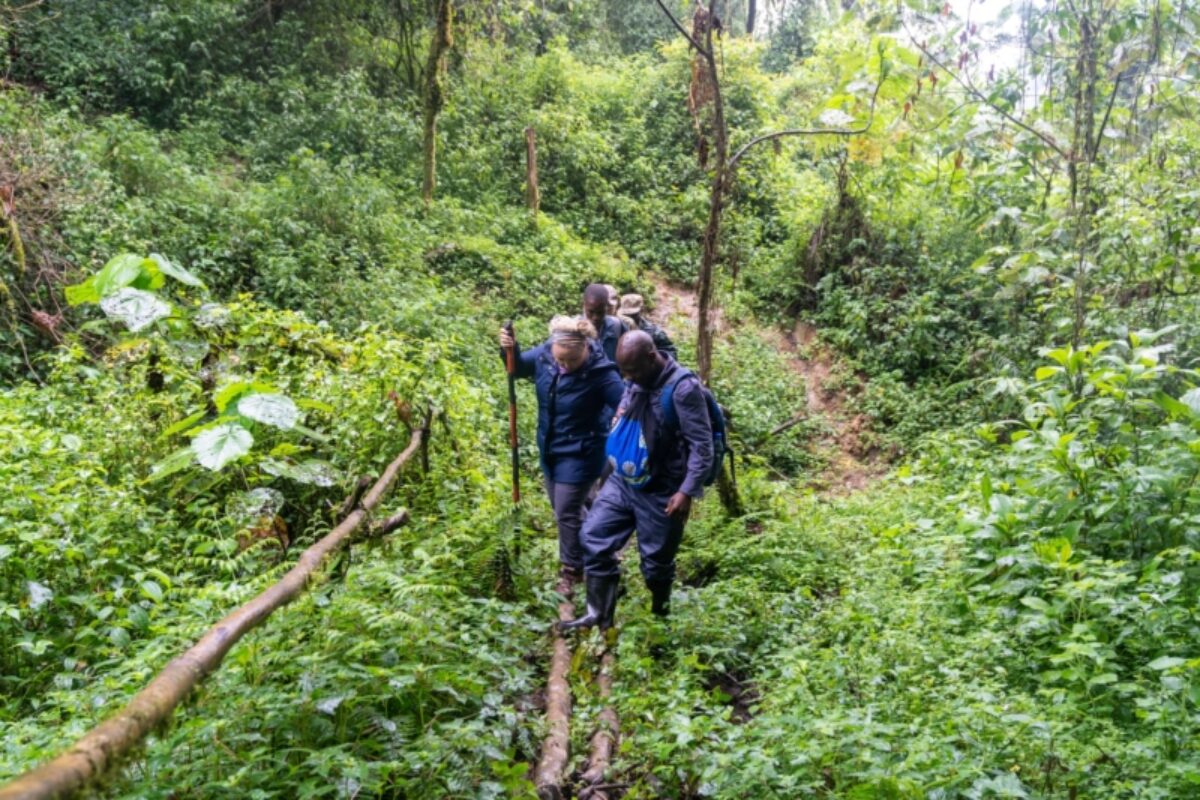
Crossing a bridge with the welcome support of a porter in Bwindi
Speak up before setting off!
The gorilla family that you’re assigned to visit is determined by your group’s trekking ability and preferences.
The park authorities closely monitor the whereabouts of each family and they have a good idea of their distance from headquarters. Some families are within an hour of easy hiking, others could be four or more hours away from HQ. The authorities will assign you to a gorilla family that is suited to your preferences and personal fitness.
So, if you have any preferences for a shorter (or longer) trek, I urge you to speak up at the morning briefing and you’ll be assigned to track the most appropriate gorilla family.
If you’re travelling with a big group this could mean splitting up – younger or fitter members trekking to a more distant family, and older or less mobile members visiting a more accessible family. It’s up to you, and the rangers will try to accommodate your preferences.
My number one gorilla trekking tip
My advice is to make this experience much more than ‘just’ seeing the gorillas. Your encounter with the gorillas is strictly limited to 60 minutes, which will fly by before you know it. But during the rest of your trip you’ll experience a part of the world that few others get to visit. You’ll see astonishing scenery, all sorts of other wildlife, and get to witness local people living their lives in this amazing setting. The gorillas are the crowning jewel, but don’t forget about the rest of the treasure trove on your race to see them.
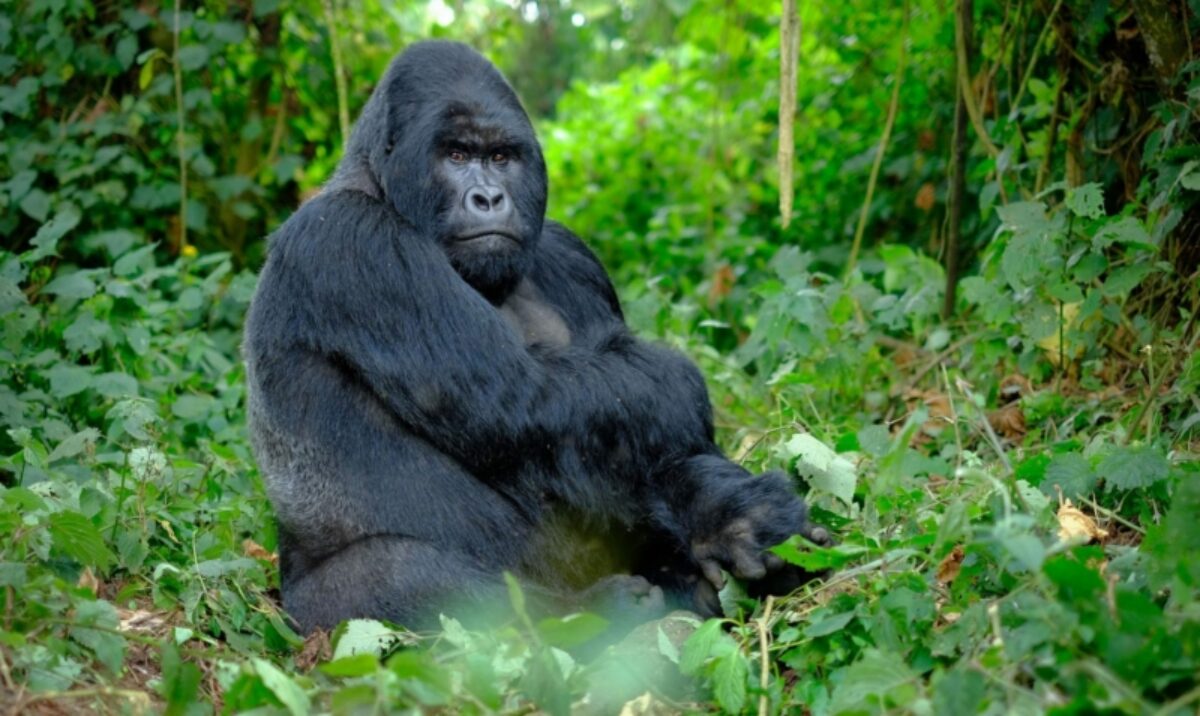
Up close and personal: Meeting a silverback on a gorilla trek in Rwanda
Costs & permits
Permit availability is limited and is determined by the number of habituated gorilla families in each country. Permits can sell out months in advance, especially during peak season.
The current cost of a permit for a foreign non-resident is USD $1,500 in Rwanda, USD $700 in Uganda and USD $400 in the DRC. This fee includes park entrance, and all guiding and tracking services (which are provided by the park, not by individual operators), but it does not include an optional porter to carry your day pack.
It's possible to organise a DIY gorilla trek in Rwanda by purchasing a permit directly from the Rwandan Development Board and then booking your own accommodation and transportation. In Uganda foreigners can only secure a permit via an authorised tour operator.
Other costs will depend on how you arrange your trip. Most visitors book an all-inclusive organised tour using midrange or luxury lodges. Standalone two- or three-day tours of this sort might cost anything from USD $1,500 per person to USD $5,000 and up, depending largely on the quality of accommodation.
If the cost of a gorilla permit and accommodation feels too high, I often recommend chimpanzee trekking as a lower-cost alternative for budget-conscious travellers. And if you can afford both, it also makes an excellent add-on to a gorilla trek!
Don’t ignore off-season
In my experience, the best conditions for gorilla trekking in Rwanda are during the two dry seasons which run from June-September, and December-February. (Note that climate change is disrupting the timing of these seasons.) The advantages to tracking in dry season are less muddy paths, easier hiking and clearer views. The disadvantage is that these are the peak gorilla trekking seasons, demand for permits is higher, and accommodation is more expensive. You’ll need to book well in advance.
The rainy seasons, from March-May and September-November, can be very soggy but if you don’t mind the rain (and mud) the mountains will be quieter and you may find some good deals on accommodation. Saying that, just because it is called the rainy season, it doesn’t mean that it rains every day. There is no off-season discount on the gorilla trekking permit.
Whenever you come, you must bring your rain gear and some decent boots. Mountain gorillas live in the rainforest and most days have heavy dew, a light shower, a downpour, or all of the above!
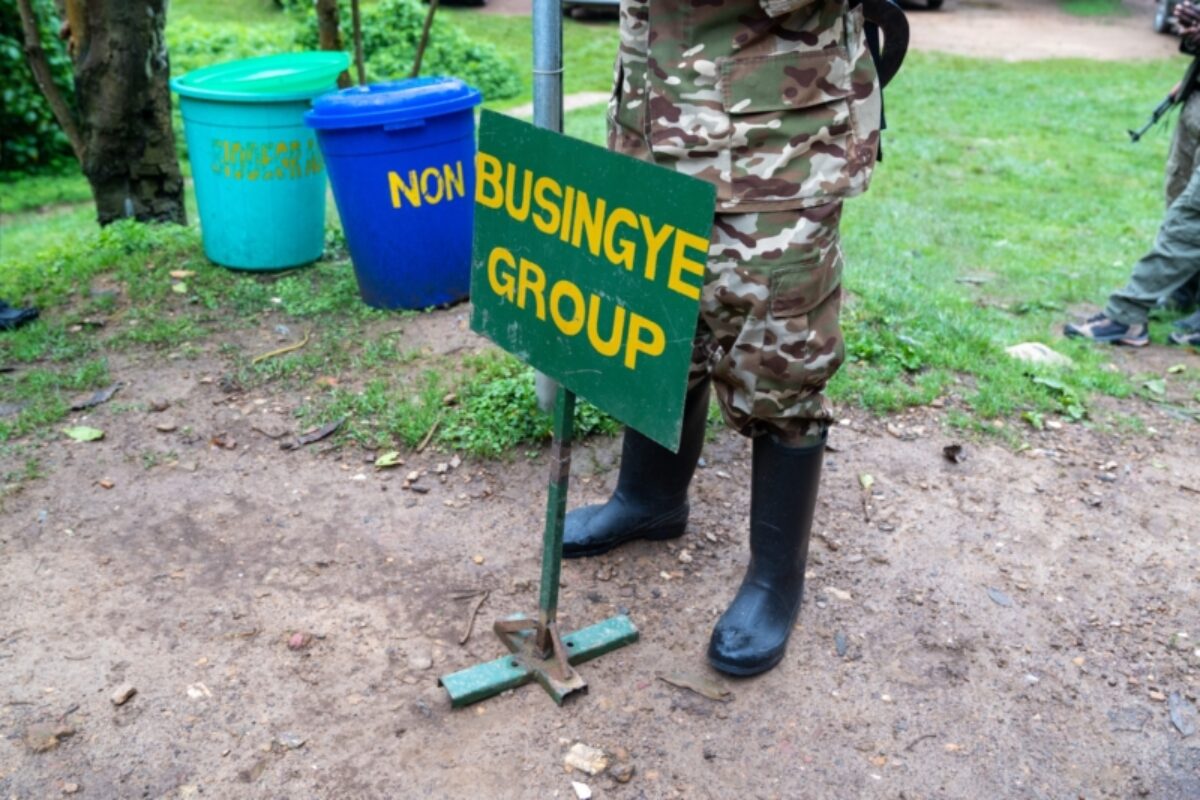
Meeting point for the group tracking the Busingye family in the Rushaga sector, Bwindi Impenetrable Forest
Important! In Uganda, where you stay matters
Unlike in Rwanda, Uganda’s gorilla population is more dispersed and gorilla trekking here requires more planning.
The gorillas of Bwindi Impenetrable Forest are scattered across four distinct areas: Buhoma, Nkuringo, Rushaga and Ruhija. In each area the gorillas are various distances from the entrance, and the terrain can vary greatly – which means an easier or harder trek depending on which area you visit.
Generally speaking I recommend Buhoma for easier-going treks and Nkuringo for longer and more challenging treks. Rushaga has the most permits, and Ruhija is good for birdwatching, although you'll probably need to do a separate (quieter) guided birdwatching hike after your gorilla trek.
The other key factor to bear in mind is to ensure your accommodation is not too far from your chosen trekking area. You have to be at the relevant entrance for the 7:00am briefing, so you should book a lodge that is not too far away from your chosen area entrance.
This only really matters if you’re booking your travel arrangements independently. If you’re using a specialist tour operator they’ll make the best match for your interests, budget and hiking ability.
In Rwanda, ignore whistle-stop itineraries
Standard tour itineraries tend to rush you through the gorilla trek and onwards to other lucrative destinations elsewhere in East Africa. In Rwanda I've even seen an itinerary that has you fly in, see the gorillas, and fly out all on the same day.
While these itineraries are technically possible, I really don't recommend them – there's much more to Rwanda (and Uganda) than one hour with the gorillas!
My advice is to slow right down, and appreciate the privilege of being able to visit this little corner of a vast continent. By all means combine your trip with some of the other East African ‘big hitters’, but treating the entire country as a springboard to just see the gorillas just feels wrong to me.
Don’t overlook local operators
There are many locally-based operators as well as international travel companies, often with stark price differences between the two. International travel companies often subcontract local operators to run their ground operations, so you may wonder why you’re paying a premium to a middleman. Generally speaking, international operators can offer an extra edge on pre-trip communication, higher-end lodges, more hand-holding, and stronger financial protection.
On the other hand, a good local tour operator will have a stronger grounding in the local community and customs, might use smaller, independent accommodations or homestays, and can generally get you out of the international tourism bubble. And the biggest factor for me: much more of your money will stay in the local economy, instead of being syphoned off abroad.
My advice as a 15-year resident of East Africa: embrace the local connection, don’t rely on the highly curated experience of an international company. Dance with the locals, make banana beer, get your hands dirty and do a bit of digging in the fields. Get out of your comfort zone and find out what local life is really like. I guarantee you will have a more memorable trip as a result.
If you do book with a local tour operator, always check independent reviews and ensure they’re registered with the Rwanda Tours and Travel Association or the Uganda Tourism Board. In addition, you may check they are registered with
the Association of Uganda Tour Operators, the Exclusive Sustainable Tourism Association, and/or YUTO. Pay by credit card for financial protection, and always make sure you’re covered with travel insurance from time of booking.
Gorilla trekking rules & guidelines
Tourists are only allowed to visit and interact with habituated mountain gorilla families. Habituation is a gradual process through which the gorillas get used to the presence of humans. This allows people to visit the gorillas without affecting their daily lives or natural behaviour.
Although the gorillas are habituated, the Rwanda Development Board and the Uganda Wildlife Authority enforce strict rules governing how tourists can interact with the animals. The following are for the safety and wellbeing of the gorillas and tourists and are considered non-negotiable:
- Your group is allowed a maximum of one hour with the gorillas.
- Visitors must be over the age of 15.
- The maximum group size for tracking the gorillas is eight people (plus rangers and porters).
- Hiking in thick forest at an altitude of over 2,000 metres (6,560 ft) can be tough. It is often wet. Visitors must be fit and in good health.
- You should not visit the gorillas if you have Covid-19, diarrhoea, flu or a cold. Gorillas have no immunity to most human diseases and even mild human infections can be lethal to a gorilla. The Covid-19 pandemic made us even more aware of the risk we pose to them. You are obliged to inform the authorities if you are sick and they will decide if you are well enough to visit the gorillas. Remember that the lives of the endangered gorillas are more important than your holiday.
- If you need to sneeze or cough, cover your nose and mouth to reduce the chance of spreading infection.
- Don't spit or leave litter in the forest. Gorillas can catch diseases from human rubbish.
- Always leave a distance of ten metres between you and the gorillas. If the gorillas start moving towards you, the rangers may advise you to move away from them.
- Gorillas can be quite curious. Do not touch the gorillas, even if they come close to you.
- Do not make any sudden movements.
- If a gorilla charges, do not run away. Avoid direct eye contact until the gorilla has moved away. Stay calm and slowly crouch down.
- Stay in your group. Do not crowd or surround the gorillas.
- If you need to go to the toilet in the forest, tell your guide and he will dig a hole for you. Cover the hole afterwards to prevent spreading disease to the gorillas.
- Flash photography is strictly forbidden.
Follow these simple, common-sense rules and your gorilla trek will be a positive one—for the gorillas as well as yourself!
Gorilla trekking FAQs
Your questions, our expert answers
Question
Is gorilla trekking hard?
Answer
This is the first question most people ask me. It’s hard to answer because it depends on where you go, the weather, and how long it takes to find the gorillas, all of which can vary from one day to the next.
In my experience, however, moderately fit people under the age of 60 are unlikely to find it particularly tough. Older and less fit travellers may find it more challenging; even so, the odds of locating gorillas is better than 99%, and your exhaustion is sure to dissipate when this happens.
Question
We are six Baby Boomers planning to see the gorillas. One of us will be 82 and although in great shape, we won’t be able to hike for hours to see them. Will that work, and will there be porters to assist us?
Answer
This isn’t medical advice but it sounds to me like you'd be fine. I always recommend hiring a porter regardless of age; it's a huge help to have someone carry your stuff and leave your hands free for taking photos.
If you think you need some extra support you can hire a group to carry you on a rather unglamorously-named "stretcher" (it's better than it sounds!) You generally pay $10-$15 per person for the porter, and you might consider adding a tip of a similar amount. The "stretchers" cost around $100. These services are community-run initiatives and are a big boost to a family's income. All this can be arranged on the morning of your trek, during your briefing.
Also consider the location of your lodge and the gorilla family that you're assigned to track. Don't be shy in stating your tracking preferences during the morning briefing. The rangers want everyone to have a good – and safe – time so they will do their best to make sure that people with similar fitness levels are grouped together and assigned to track a more accessible gorilla family.
The Habinyanja family in Buhoma (Uganda) is well-known for being quite close to a number of the lodges. I tracked this same family a few years ago and had a lovely hour in search of them, before spending an hour with them. It took a little less than an hour to get back to the lodge, so about a three-hour round trip. Your tour operator should be able to identify a gorilla family and lodge combination that suits your fitness and ability levels.
Good preparation is also important. Local people love wearing gumboots (they keep out the ants as well as the mud) but walking boots with ankle support are the best option I'd say. I'd suggest bringing walking pole(s) or a stick. Sticks can also be bought or borrowed from your lodge.
Question
Is gorilla trekking worth the money?
Answer
If you do a search for this question you'll find hundreds of pages – mostly from companies selling gorilla treks – saying yes it's definitely worth the money. My reply is more qualified: if you have to ask, the answer might actually be no!
For many, seeing the gorillas is a once-in-a-lifetime experience. Personally I love it so much I’ve been four times!
But whether it is quite so life-changing for you depends on how passionate you are about wildlife encounters, hiking, (and early morning starts!) I actually think you’re most likely to be disappointed if your entire trip revolves around just seeing the gorillas – after your 60 minutes, the rest of the trip might feel anticlimactic. It should be regarded as a whole day’s activity in a pristine natural environment, not just the single hour with the great apes.
To get maximum value from the experience, make sure you’re prepared. Be as fit as possible, wear the right gear, rest well and don’t try to pack too many activities into your itinerary. These are both fascinating countries with much more than ‘just’ gorilla tracking; slow down and round out your experience by getting to know the rest of the country.
Question
Why are gorilla permits so expensive?
Answer
Seeing mountain gorillas in either country isn’t cheap. The combined cost of permits, accommodation, guides and a tour can bring overall trip costs upwards of $2,000 per person. So why are gorilla treks so expensive?
The main reason is that mountain gorillas are endangered and vulnerable to uncontrolled human interaction. One of the biggest threats to the gorillas’ survival is disease. Gorillas share 98% of their DNA with humans, making them highly susceptible to infection from human diseases. Therefore the authorities (wisely, in my opinion) tightly restrict and control the number of interactions the gorillas have with people.
And it takes money to protect the gorillas’ natural habitat. A significant percentage of gorilla permit fees goes into conserving the gorillas’ mountain forest habitat. Finally, some of the money you pay will go into research and monitoring of the gorillas, as well as paying your guides and encouraging sustainable tourism. The authorities point to the growth in gorilla numbers as evidence of their success.
On balance the price might not be low, but in my opinion it’s still pretty good value considering the importance of protecting this endangered primate.
Question
Is there an age limit?
Answer
The minimum age to visit gorillas in both countries is 15. You will need to provide your passport when you book your permits and park authorities will use your passport to verify your birthday matches the date given on your gorilla tracking permit.
Question
Is gorilla trekking safe?
Answer
Despite their size and unfair reputation, gorillas are not remotely dangerous provided they’re treated with appropriate respect. All gorilla treks are accompanied by expert ranger guides who spend most of their time with the mountain gorillas. You’re only allowed to visit gorilla groups who have been habituated to the presence of humans, meaning they are used to having people near them and understand that you’re not a threat.
Gorillas are normally shy and reserved, spending the majority of their time feeding and looking after their young. However, they—like any wild animal—can exhibit defensive behaviour if they feel uneasy, particularly around their young. Your guide will recognise the signs; they may include ‘mock charging’, aggressive beating of their chests and grunting. Always follow your guide’s lead, but if faced with an aggressive gorilla, crouch down, look away and try to act relaxed. Your guide will advise you further during the pre-trek briefing.
Question
Should I book a gorilla trek with a local or international operator?
Answer
There are many locally-based operators as well as international travel companies, often with stark price differences between the two. International travel companies often use local operators to run the ground operations, so you may wonder why you’re paying a premium to a middleman. Generally speaking international operators can offer an extra edge of communication, more hand-holding, and stronger financial protection. To help keep more of your money within the local economy I think it’s worth considering booking locally, but do check independent reviews and try to pay on a credit card and with travel insurance for financial protection.
Question
How close can you get to the mountain gorillas?
Answer
Regulations state that you must stay 10 metres from the gorillas at all times and only spend one hour with them. In practice, inquisitive gorillas may come closer to you on your trek. If they do, stay calm and quiet, follow your guide’s advice and never touch the gorillas. Keep your voice low and avoid eye contact.
The gorillas will normally be more relaxed the further back you are. Your guide may ask your group to move to a different location to calm the gorillas or to get a better view.
Question
What should I pack for a gorilla trek?
Answer
Your day of gorilla tracking will be long, active and may be fairly arduous. You’ll be hiking in thick forest in a changeable climate. Evenings can be cold; mornings are cool, and the days are hot—especially when you’re clambering up a muddy mountainside. Having the right gear makes all the difference:
A small backpack to carry water, packed lunch and rain jacket.
Walking boots or hiking shoes. Boots are ideal for the extra ankle support on rocky and muddy terrain. Another option (that is particularly popular with locals) is plastic gumboots. Not only do they keep your feet dry, but they keep insects—particular ants—at bay.
Long socks will allow you to tuck in your hiking trousers and protect your ankles from scratches and biting insects. Higher-end lodges may loan gaiters to guests.
Lightweight waterproof jacket.
Hiking pants or waterproof trousers (handy when sliding down muddy slopes!) Do not wear jeans or shorts: hiking in wet jeans can be miserable and shorts will leave you exposed to hungry insects and scratches from thorns.
A long-sleeved shirt offers much needed protection from the sun and insects.
A fleece or light-wool sweater for cold mornings.
Cheap gardening gloves will protect your hands but aren’t essential.
Sunglasses, sunscreen and sunhat.
Camera (and associated paraphernalia). Although some people take binoculars, you aren’t very likely to use them. You will spend most of your time in the forest where trees will obscure most things.
Many visitors—regardless of age or fitness—find walking poles useful and many upmarket lodges provide wooden poles. In VNP your guide can cut you a custom-made pole from bamboo!
At least one litre of drinking water and your packed lunch.
A basic first aid kit may come in handy: antiseptic wipes, antihistamine cream, insect repellent, plasters, painkillers, and rehydration sachets.
Question
Can I organise a DIY gorilla safari in Rwanda?
Answer
There are two ways to organise a gorilla safari in Rwanda. You can either secure a permit yourself through the Rwanda Development Board and then try to book your transport and accommodation independently. You'll need to get yourself to the park entrance for the morning of your trek, if you book in a lodge near VNP they should be able to arrange transport for you.
Or you can book the whole thing through a licensed tour operator who will arrange your gorilla tracking permit, accommodation and all the necessary logistics. My advice is to book your trip with a tour operator. Rwanda is an easy place to travel around but things can go wrong, and their help can be invaluable.
Question
We have hotel reservations for Bwindi, but need to buy gorilla tracking permits. How can we buy the permits?
Answer
In Uganda, international visitors must buy gorilla tracking permits via a tour operator. Only Ugandan residents can buy permits directly from the office in Kampala.
I recommend travelling with a tour operator that is registered with the Uganda Tourism Board. In addition, you may check they are registered with
the Association of Uganda Tour Operators, the Exclusive Sustainable Tourism Association, and/or YUTO.
You'll need to give the tour operator the name of the lodge where you are staying. This is because gorilla tracking is an early morning activity so ideally they'll book permits for a gorilla family that is a short walk / drive from your lodge.
Question
I'm trying to purchase a gorilla tracking permit for Rwanda but the website isn't working, what should I do?
Answer
Unfortunately the Rwanda Development Board gorilla permit portal can be unreliable! You may want to contact them directly on reservation@rwandatourism.com, alternatively you'll probably find it a lot easier to purchase your permits via a tour operator.
Question
I am considering a gorilla safari in Rwanda in the first week of October. What is it like in terms of rain? I'm not super fit, is it likely to be very muddy and challenging? Thank you!
Answer
If you're tracking in Rwanda at the beginning of October, you may be lucky and not have too much rain. (It's November that is typically the wettest season during the year's late rains).
But to be honest, it can rain any day of the year, particularly in the afternoons. However, with good preparation you can still enjoy visiting the gorillas.
Firstly, make sure you have the right equipment: sturdy walking boots that cover and support your ankle, for example. Locals often prefer wearing gumboots but I prefer the non-slip grip of walking boots. Regardless of the time of year you track, we always recommend wearing layers e.g. thin longsleeve T-shirt, a light pullover fleece, plus a rain jacket. On the day you track, the rangers will assess your fitness level, and allocate you a group to suit you.
You don't need to be mega fit. You will be supported by the rangers and can also hire a porter. Invaluable! This means you don't have to worry about carrying your backpack. Nor do you need to worry about the mud, the weather or the distance since you'll have plenty of hands to literally lift you up, if needs be. You can also borrow, buy or hire a walking stick. Sometimes, someone will grab a piece of bamboo and make you one.
Make use of every bit of help that is offered. It's all part of the fun! I think you'll be fine. Enjoy!

